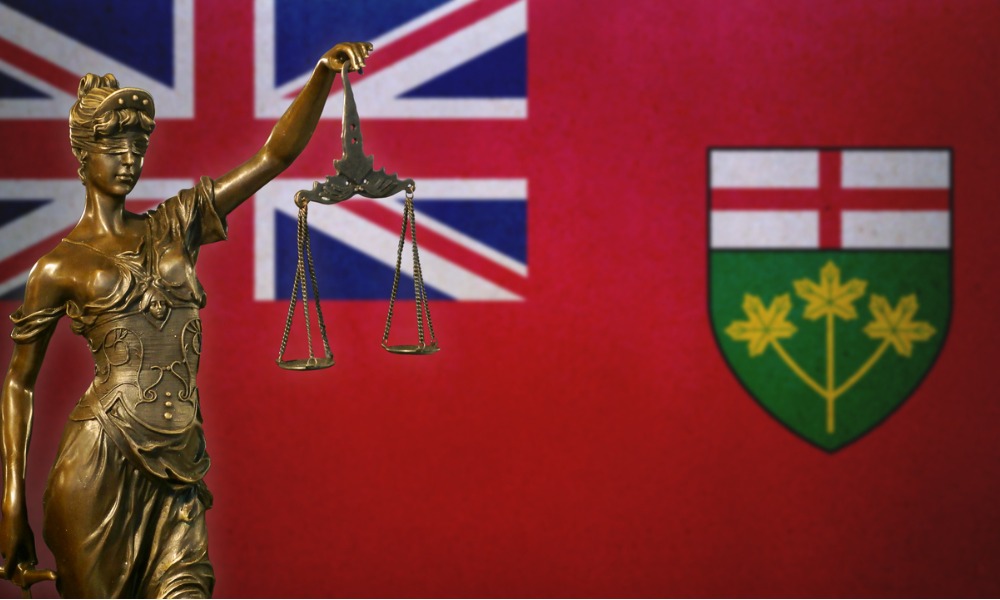Calendar year 2004 brought "waiver of tort" to Ontario by way of Serhan v. Johnson & Johnson (Surestep), a product liability case involving home-testing kits for diabetics. And in June 2006, a divided Divisional Court kept it alive.
 Waiver of tort, an unjust enrichment concept, requires defendants to disgorge revenues garnered from defective products. This relieves plaintiffs of the need to prove individual damages - which so far has been the biggest obstacle to certification.
Waiver of tort, an unjust enrichment concept, requires defendants to disgorge revenues garnered from defective products. This relieves plaintiffs of the need to prove individual damages - which so far has been the biggest obstacle to certification.
Indeed, Ontario Superior Court Justice Maurice Cullity certified the class in Surestep although no class member suffered health problems or economic loss. Ironically, neither of the lead plaintiffs had even paid for the defective device, which was covered by Ontario's drug benefits program.
Cullity's decision is rooted in a liberal approach to waiver of tort.
"Typically, waiver of tort applies only when you're dealing with a fiduciary or contractual relationship, but Cullity drove a truck through that loophole," says Doug Harrison of Stikeman Elliott LLP's Toronto office.
"This could be one of the most important product liability cases we've ever had in Canada, and it also opens the door to punitives if the defendant's behaviour is egregious enough."
Paul Pape, who represented the plaintiffs in the Divisional Court, hailed the decision.
"Judges have been reluctant to certify common issues when there are many more miles to go in proving individual damages," he told Law Times.
Surestep could result in streamlined access to class actions, Pape added.
For his part, Harvey Strosberg of Windsor's Sutts Strosberg LLP, co-counsel with Pape before the motions judge, called the case "a missile in our arsenal," a position that Pape endorsed after Cullity's decision.
"If there's any colourable conduct beyond mere negligence, the ways in which waiver of tort can be applied are limited only by counsel's imagination," he said.
But Johnson & Johnson, represented by Michael Barrack of McCarthy Tétrault LLP's Toronto office, applied for leave to appeal to the Divisional Court.
In granting leave, Justice John Ground noted that it's unclear whether waiver of tort is a standalone cause of action or merely a choice of remedy by a plaintiff who has established an actionable wrong.
But justices Gloria Epstein and John Jennings, over the dissent of Justice Sandra Chapnik, upheld Cullity's refusal to strike the waiver of tort pleading.
"The issues that will arise at the trial of the common issues will unquestionably be difficult," Epstein wrote for the majority at the Divisional Court. "The plaintiffs will have to make complex submissions about their entitlement to an interest in the defendants' revenues. They may well have to make novel arguments concerning corrective justice.
"It may be that applying either remedy, a constructive trust or disgorgement, to this type of situation would take 'corrective justice' too far and at trial the plaintiffs may find themselves without a remedy," said the ruling.
"However, that a pleading reveals an arguable or difficult point of law cannot justify striking it out."
Pape said the majority decision represents another blow to the "say no to everything, the sky is falling" argument that pervades the submissions of counsel for defendants in class actions.
"They'll say anything that will terrify the court into refusing to advance the development of the law," he said.
Barrack would not comment on the case while it was before the courts.
As Epstein saw it, the core issue was whether it was "plain and obvious" that a claim relying on waiver of tort as a cause of action would fail in circumstances where the plaintiffs might be entitled to a constructive trust or an accounting and disgorgement of profits.
She concluded that it was not, agreeing with Cullity that whether waiver of tort was an independent cause of action should be resolved in the context of the factual background and more fully developed record that a trial would provide.
This left the issue of whether waiver of tort allowed for a constructive trust as a remedy. While the plaintiffs faced difficulty in meeting the requirements for a constructive trust based on wrongful conduct and in dealing with the implications of extending constructive trusts to the situation at hand, it could not be said that such a claim must surely fail.
"These arguments and concerns [expressed by the defendants] are not only open to debate but also engage important policy issues," she wrote. "It follows that they should be examined fully and resolved on the basis of a complete factual record, not in the course of a procedural motion."
The remedy of disgorgement also required jurisprudential clarification.
"Questions of the circumstances under which manufacturers and distributors of health care products might have to disgorge their profits and to whom or to what entities the assets in issue may be directed need to be developed on the basis of a full factual record," Epstein wrote.
"At this preliminary stage Cullity J. was correct in concluding that a claim based on waiver of tort giving rise to the remedy of disgorgement and an accounting was not certain to fail."
Chapnik's view, on the other hand, was that the claim would indeed fail at trial.
"It is my view that in the instant case, given the cumulative impact of the absence of an agency, trust, or fiduciary relationship, and the failure to prove any loss or damage or injury to the plaintiffs that corresponds to the defendants' profit, the pleadings clearly do not disclose a viable cause of action in waiver of tort which would support either of the restitutionary remedies [sought by the plaintiffs]."
Chapnik was not, however, prepared to say that waiver of tort could never be an appropriate cause of action.
"The time may be ripe to recognize and bring emerging and novel concepts into our law of torts," she wrote.
"Waiver of tort as a cause of action fits the bill. Nevertheless, as this basically introduces strict liability for a defective product into our law, the judiciary must be vigilant in setting its parameters."
"In a different set of circumstances, it may well be prudent to allow such a cause of action to proceed as a class proceeding. As I said at the outset of these reasons, however, this is not the case in which the concept should be tested."
 Waiver of tort, an unjust enrichment concept, requires defendants to disgorge revenues garnered from defective products. This relieves plaintiffs of the need to prove individual damages - which so far has been the biggest obstacle to certification.
Waiver of tort, an unjust enrichment concept, requires defendants to disgorge revenues garnered from defective products. This relieves plaintiffs of the need to prove individual damages - which so far has been the biggest obstacle to certification.Indeed, Ontario Superior Court Justice Maurice Cullity certified the class in Surestep although no class member suffered health problems or economic loss. Ironically, neither of the lead plaintiffs had even paid for the defective device, which was covered by Ontario's drug benefits program.
Cullity's decision is rooted in a liberal approach to waiver of tort.
"Typically, waiver of tort applies only when you're dealing with a fiduciary or contractual relationship, but Cullity drove a truck through that loophole," says Doug Harrison of Stikeman Elliott LLP's Toronto office.
"This could be one of the most important product liability cases we've ever had in Canada, and it also opens the door to punitives if the defendant's behaviour is egregious enough."
Paul Pape, who represented the plaintiffs in the Divisional Court, hailed the decision.
"Judges have been reluctant to certify common issues when there are many more miles to go in proving individual damages," he told Law Times.
Surestep could result in streamlined access to class actions, Pape added.
For his part, Harvey Strosberg of Windsor's Sutts Strosberg LLP, co-counsel with Pape before the motions judge, called the case "a missile in our arsenal," a position that Pape endorsed after Cullity's decision.
"If there's any colourable conduct beyond mere negligence, the ways in which waiver of tort can be applied are limited only by counsel's imagination," he said.
But Johnson & Johnson, represented by Michael Barrack of McCarthy Tétrault LLP's Toronto office, applied for leave to appeal to the Divisional Court.
In granting leave, Justice John Ground noted that it's unclear whether waiver of tort is a standalone cause of action or merely a choice of remedy by a plaintiff who has established an actionable wrong.
But justices Gloria Epstein and John Jennings, over the dissent of Justice Sandra Chapnik, upheld Cullity's refusal to strike the waiver of tort pleading.
"The issues that will arise at the trial of the common issues will unquestionably be difficult," Epstein wrote for the majority at the Divisional Court. "The plaintiffs will have to make complex submissions about their entitlement to an interest in the defendants' revenues. They may well have to make novel arguments concerning corrective justice.
"It may be that applying either remedy, a constructive trust or disgorgement, to this type of situation would take 'corrective justice' too far and at trial the plaintiffs may find themselves without a remedy," said the ruling.
"However, that a pleading reveals an arguable or difficult point of law cannot justify striking it out."
Pape said the majority decision represents another blow to the "say no to everything, the sky is falling" argument that pervades the submissions of counsel for defendants in class actions.
"They'll say anything that will terrify the court into refusing to advance the development of the law," he said.
Barrack would not comment on the case while it was before the courts.
As Epstein saw it, the core issue was whether it was "plain and obvious" that a claim relying on waiver of tort as a cause of action would fail in circumstances where the plaintiffs might be entitled to a constructive trust or an accounting and disgorgement of profits.
She concluded that it was not, agreeing with Cullity that whether waiver of tort was an independent cause of action should be resolved in the context of the factual background and more fully developed record that a trial would provide.
This left the issue of whether waiver of tort allowed for a constructive trust as a remedy. While the plaintiffs faced difficulty in meeting the requirements for a constructive trust based on wrongful conduct and in dealing with the implications of extending constructive trusts to the situation at hand, it could not be said that such a claim must surely fail.
"These arguments and concerns [expressed by the defendants] are not only open to debate but also engage important policy issues," she wrote. "It follows that they should be examined fully and resolved on the basis of a complete factual record, not in the course of a procedural motion."
The remedy of disgorgement also required jurisprudential clarification.
"Questions of the circumstances under which manufacturers and distributors of health care products might have to disgorge their profits and to whom or to what entities the assets in issue may be directed need to be developed on the basis of a full factual record," Epstein wrote.
"At this preliminary stage Cullity J. was correct in concluding that a claim based on waiver of tort giving rise to the remedy of disgorgement and an accounting was not certain to fail."
Chapnik's view, on the other hand, was that the claim would indeed fail at trial.
"It is my view that in the instant case, given the cumulative impact of the absence of an agency, trust, or fiduciary relationship, and the failure to prove any loss or damage or injury to the plaintiffs that corresponds to the defendants' profit, the pleadings clearly do not disclose a viable cause of action in waiver of tort which would support either of the restitutionary remedies [sought by the plaintiffs]."
Chapnik was not, however, prepared to say that waiver of tort could never be an appropriate cause of action.
"The time may be ripe to recognize and bring emerging and novel concepts into our law of torts," she wrote.
"Waiver of tort as a cause of action fits the bill. Nevertheless, as this basically introduces strict liability for a defective product into our law, the judiciary must be vigilant in setting its parameters."
"In a different set of circumstances, it may well be prudent to allow such a cause of action to proceed as a class proceeding. As I said at the outset of these reasons, however, this is not the case in which the concept should be tested."







